Patrice Rayon:
Good morning Sebastien.
More than 3 years have passed since the beginning of the Precious Time project... What are the main difficulties you've been through?
| Sebastien Charlier: Good morning Patrice, thank you for receiving me. In
fact, I simply took my time... Everything passes so fast! I've been
involved in several projects at the same time, and it was necessary to
manage priorities in order to complete this project successfully. I
wanted to work the most precisely possible on all stages, which
inevitably took time, from co-composition (with my usual partner
Nicolas Espinasse) up to the mastering (done at Color
Sound Studio). Everything took time, not really more than I
expected, but a lot of time: precious time J.
|
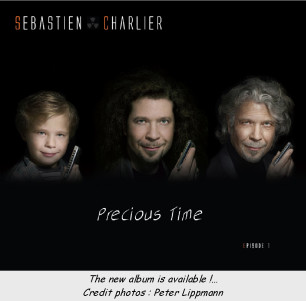 |
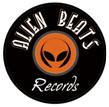 |
In fact, music is ended for months, but I had to set up a production structure, to feel really autonomous and be able to realize my project in right conditions. Creating a firm is very much time consuming... but Alien Beats Records is officially set up for few weeks now... and it is really exciting. |
Patrice:
How can you improvise on a blues harp like any musician would do on a more common instrument? One do not easily recognize the harmonica: licks are very unusual and closer to what can be heard on a sax, a guitar, or even a keyboard!
SebCharlier:
I've always worked my instrument like any other one. And I think my relation to music takes the lead on my harmonica player side. My influences come from the music I used to listen to when I was a teenager, and that I still love... they more come from musicians like Holdsworth, Hancock, Dolphy, than Little Walter, Sonny Boy Williamson, Junior Wells... even if I really appreciate the harmonica players I've discovered lately. Some of them propose fresh and new interesting things. A lot of events have happened in the small world of the harmonica. But the harmonica remains very rare in Jazz. This music needs a tremendous amount of work and may be perceived as painful. Beginners on diatonic aren't usually ready to spend hours daily working on music. I guess it is not yet part of this instrument culture.
Patrice:
Where does the very particular sound of this album come from? Which effects do you use?
Sebastien:
You mean for the electrical sound? I use different kind of effects: an octaver, a multi-band compressor, delays, a reverb, an ampli simulation, a preamp, a whammy (punctually, when overnote bends are not sufficient to get specific pitch effects), an equalizer, a hush, a fuzz which I use like an enhancer to compensate the bottom coming from the octaver, a standard microphone ...
Pat:
One can even play guessing when the harmonica appears. Most of the time one can guess, but sometimes it is not so clear, despite the instrument recognizable particularities.
Seb:
In fact there are only 2 sounds: the easily recognizable
acoustical sound and the electrical one J
Once the electrical sound has been identified (and it is
rather simple since it's often heard), it becomes rather obvious. I
think the difficulty to identify the harmonica comes from the licks,
which are quite far from what we are used to hear on a diatonic.
Concerning the organ sound, I use it only once, on Sin Chronic City.
It definitely is a harmonica, but the sound passes through many
external effects which transfigure it.
| Pat: During the 2009 Roses Summer Workshop you've explained us your way of working, and your impressive weekly working plan. When speaking about you, I usually say that I perceive you as a sort of French Howard Levy (even if your two playing differ quite a lot), because you push back this instrument physical limits, at least the ones we usually imagine. Do you think you may be one day satisfied with your playing on a diatonic, or will you always be a rebel fighting against the harmonica theoretical boundaries? Wouldn't you be trying to overpass what one can do with a "wind controllerâ, for example? Seb: It's nice comparing me with this exceptional harmonica
player, Patrice.
|
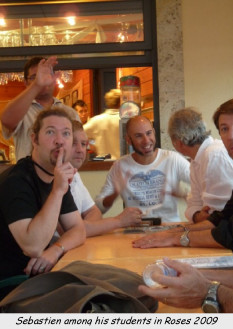 |
We share a common essential choice: playing chromatically on a diatonic, and we try, as all other harmonica players I guess, to develop our own musical universe using our own resources. I don't feel like a rebel at all, Patrice... I just play what I think I am able to play. Boundaries are purely psychological. I continue to practice my instrument every day, and still discover tons of things. I am persuaded that it is always possible to improve.
I do not know what a "wind controllerâ can do, I just know what I can do with it. Each musical instrument has its own physical limits, but they more correspond to what the musician can or can't do... All depends on your technical level, and musicality is far from being only linked to this level. Plus these limits may be different than the ones we imagine.
I switch to the "wind controllerâ when I feel it would sound more appropriate. If not, then great, I'm happy to play the harmonica. This choice more depends on the tune I play than on what I can or can't do with each instrument ...
Music must take the lead and become emancipated from the technical work, as well as from each instrument ergonomics. A player may think this or that lick is impossible on his instrument, whether another one will play it easily... To me, there is no hierarchy of ergonomics, which would impose boundaries. Of course there are obstacles, but all instruments have some... You just have to practice another instrument seriously to understand that. There is still always something to be said musically, according to each one's capacities, feelings, and this is what music is all about, isn't it?
Pat:
The diatonic harmonica is the most used type of harmonica on the planet; but there are other families of harmonicas which are not very much heard any more since "Albert Raisnerâ years. Some people would like to present these instruments as oldies, like the accordion in "musetteâ style. However the accordion isn't "musetteâ; and basses, polyphonia and other kind of harmonicas could reappear in unexpected fields, don't you think? Don't these barriers imposed in silence awake your rebel side against theoretical limits ;
|
Seb: OK, I see you definitely want me to be a rebel; so here we go for the rebel attitude J I agree with you Patrice, I'm really sure there are
tons of things that can be done with these instruments. Some devote
themselves to it, and it would not surprise me if we'd shortly discover
true findings within a very musical speech, and very far from what is
usually heard with these harmonicas.
In fact it only depends on the players. |
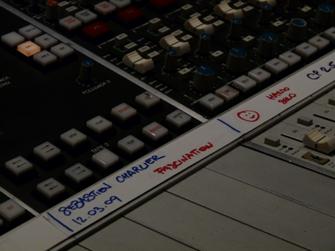 |
No instrument should be reduced to a particular style, even if some associations seem to be obvious. The diatonic harmonica showed to what extent it could propose something else than Bavarian folk music, for which it seemed to be dedicated first (and I have nothing against this music ;-)). Why not the others?...
Pat:
Howard Levy has just launched a new harp lessons web site. As one of the most reputed harmonica teachers in France, have you had a chance to see your American colleague work online? What do you think about it?
Seb:
Of course, I have. Howard and I even spoke about it on Facebook... I think it is a very good idea. It federates harmonica players willing to understand the mechanisms of a chromatic playing. It is rather logical that this pioneer of the "chromatizing diatoâ is present in this way on the net. That's what I told him.
| Pat: By hearing your playing celerity I sometimes wonder if you took breathing lessons at some point. Have you learnt a breathing technique by yourself? Seb: Surprisingly, a guitarist had explained me how my playing
celerity would be limited sooner or later if I didn't learn how to
breathe with the instrument (in opposition to breathe in the
instrument). It may sound strange, but each fast lick needs a perfect
coordination between instrumental technique and breathing control. I
think it is extremely important. Plus each instrument "gets its own
breathingâ: depending on what you want to play, you have to coordinate
its breathing with yours. Then you can play what seemed to you
unreachable.
|
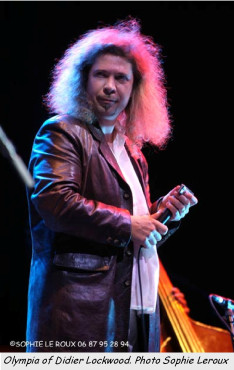 |
Pat:
You perfectly know music theory. However you never play with a music sheet under the eyes during concerts. What do you think about harmonica players using music sheets when playing in public?
Seb:
Frankly, I've rarely seen a diatonic player using a music sheet during a concert... I have one when I play with a symphonic orchestra, or during recording sessions if there are complex written parts. In Jazz, you usually have the harmony tab under the eyes, sometimes also the theme. You rarely look at it, it is rather just in case... It is mainly psychological as you are supposed to know what is to be played. But you can also have to play a jazz standard you don't know. In that case, music sheet may be of great help.
When I play my music, I don't need any music sheet, apart if there have been last changes before going on stage. But normally ears are supposed to do their job J
I guess you're thinking about chromatic players, and more particularly playing classical, aren't you? Classical is closer to a written culture I suppose. Stakes differ for an improviser, and a music sheet is efficient only very punctually.
Pat:
Your previous album Diatonic Revelation had been recorded at violinist Didier Lockwood's studio, with his team. How have you organized the recording for Precious Time?
|
Seb: Concerning Diatonic Revelation, we had plenty of time to
compose, with the pianist and organist Benoît Sourisse. But most of the
album had been recorded in 3 to 4 days. Concerning Precious Time, I
definitely wanted to take all necessary time to get into the details
imposed by Jazz Fusion. All parts were finally recorded in very
different places, quite far one from the other.
|
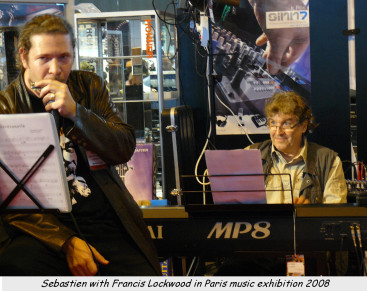 |
We wanted to give a more international dimension to the project. The drums were recorded in Los Angeles, the bass in Canada, the guitars and keyboards in France. The harmonica was recorded in all rooms of our flat (my wife Nathalie often asking me to close the doors J), from the bathroom to the kitchen ... this is the advantage of an association harmonica / laptop. Few tracks were recorded in the "La Reineâ studio (Paris, France), during the long mixing period...
Pat:
Harmonica players almost never play this style, and definitely not like that! So, why Jazz / Rock and Fusion?
Seb:
Why not? (smile)
|
The sound aspect is also extremely important. The
harmonica, probably due to its ergonomics, often pushes the player in
other directions, other kinds of music, more reachable I guess.
Concerning rhythm, it's not easy to swing when playing binary on the
afterbeat ...
In fact, I wanted to play a music which was in touch with what gave me the desire to become a musician. |
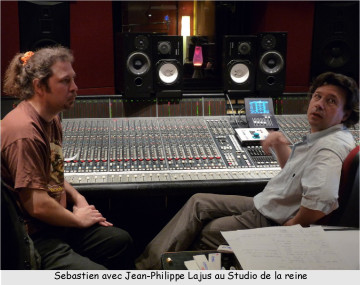 |
It is the music which I most listened to when I was a teenager, and it is still a music I rediscover daily. When I felt I had enough experience for Fusion, I asked Nicolas Espinasse to realize the album, then to Jean-Philippe Lajus to join us on the keyboards, which helped us moving forward on the arrangements. Alain Caron then joined us on the bass, and Curt Bisquera on the drums.
Pat:
Ambiences are various and beautiful: guaranteed full immersion! I sometimes feel I'm travelling when listening to this album, like in a movie. I have mentioned the "Big Blue" in an article published in H2F announcing the content of your project; does it influence the way you compose?
Seb:
You know, it is rather usual in Fusion to multiply pictures within the same tune, and to bring changes in themes and ambiences. I confess that, generally, I am more attracted to movement, therefore I really like that tunes move. Nonetheless, the maximum was made to give a very clear identity to each track. I always think of ambiences when I compose. Nicolas knowing me very well, the co-writing causes no particular conflict, phew ;-)
Concerning the "Big Blue" side, I did not think about this movie which I still haven't seen yet J. I assume that you refer to the ballade of the album: Solstice d'Ete (Summer Solstice), where Alain Caron's bass fretless takes its entire dimension. It is a tune which really sends you, even if there is a rather tribal part during the WX5 wind controller solo (electronic sax).
|
Pat: When listening to the album, I better understand the sentence I've read in your press pack: « when past plays with future ». Can you explain us this sentence, as well as the "harmonica Next Gen" logo present on your web site, in the back of the CD, and on your new Hohner poster? Seb: I very much like sentences with double meanings. The idea
of the album, and the trilogy we prepare, is a bidirectional trip on
the arrow of time. I play nowadays pieces, but also covers that
impressed me during the eighties. Past has a hold on future, and
sometimes seems to play with what unavoidably happens again and again.
|
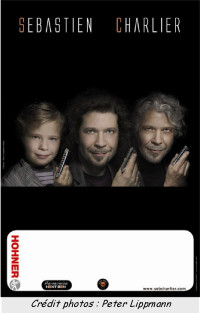 |
Concerning the "Harmonica Next Gen" logo, it is a bit an identification picture game... it will always be present on my albums and achievements, as long as they propose a harmonica playing not directly issued from the instrument ancestral tradition. This logo is a way to indicate the kind of content of the project. Taking a different example, if I recorded a more Blues/Pop oriented album, the logo would surely become: "Harmonica OldSchool". So it is a way for people to know what the project positioning is. One can imagine tons of logos... but I hope I'll use the Next Gen one many times again J.
Pat:
Everything is very precise, accurate, from all musicians, however the album is very warm, far from being insipid or impersonal, what is the recipe?
|
Seb: Nicolas and I had written and prepared everything, so we
could send scores to all musicians, as well as separated guide tracks.
But freedom remained for each instrument on some voicing. I
had Alain many times over the phone on this subject; the idea was that
each one could definitely bring his own ideas, his own personality.
Everybody played the game. I think consistency comes from there. Plus I
have the chance to play with very high level musicians, which helps a
lot...
|
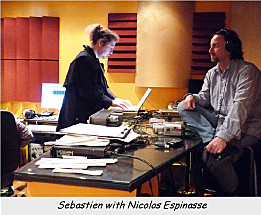 |
Pat:
Won't you have a lot of pressure playing such tunes in concert? You must be already repeating I guess, aren't you?Seb:
Pressure? Bah ... if you begin to fear playing the music you like, you'd better stop this job J. One can feel apprehensive to do well and be ready enough, of course. I always try to do my best, whatever the music is. Now, this music is very demanding, but we've been working hard, so we can't wait to play it in concert. And we've already begun to repeat, of course J.
Pat:
How many different harmonicas did you use for this album? And which make of harmonica?
Seb:
I don't remember exactly, but there are a lot of different C harps, exclusively from Hohner, sometimes within the exceptional Raymond Brodur system. I also play on my usual Meisterklass. There must be a D on Galactic Funk, Ab (Marine Band Deluxe) on Shout, on which I wanted to use the speed tonguing technique on an arpeggio sequence; I was therefore obliged to choose this specific tonality. I've changed at the end for a "question & answerâ sequence with the recorder player Benoît Sauve: I use a Db to do an implied reference to the position playing. I must be using another harp on the Sin Chronic City solo to be able to trigger the right chord at the beginning, and an alternative homemade tuning (kind of semi-diminished lydian MeisterKlass hybrid) at the end of "It" to propose another speed tonguing sequence, trying to compete with Nicolas's incredible phrasing during this friendly duel. But I mostly play on C harmonicas, on which I more easily hear the notes before playing them.
Pat:
However, tone steps from one harp tonality to another are exactly the same... How do you explain this preference for C harps?
Seb:
Well, as I told you, I think I can hear notes beforehand on my C harp now. So when I use a harmonica in a different tonality, hearing another sound than the one I expect when playing in a given hole disturbs me a bit. After few sec, relative ear takes the lead, but I still feel a light discomfort, especially when interacting with other musicians if harmonies change a lot. In that case, I can hear the keyboards playing a given note for example, and I instantly think about its position on my C harmonica... Unfortunately, I may not be using a C harp. So I have to transpose the note, which adds a step in the process I would rather have avoided.
Of course if I play in position, I do not have this problem anymore, since, as you point it, all intervals are equal between two harmonicas in different tonalities. But it is not possible to seriously play Jazz and Fusion with the position playing.
Pat:
Do you play with preferred positions? If yes, which ones? It is rather difficult to tell just by listening to your music. Where's the trick?
|
Seb: The trick is I don't play with positions, except very
punctually when it is consistent with the musical context. Apart from
that particular case, I try to play only what I hear, or what I am able
to play according to harmonies. Positions would impose boundaries. They
would not allow me to follow all modulations. As soon as you play what
you hear, positions complicate the situation.
|
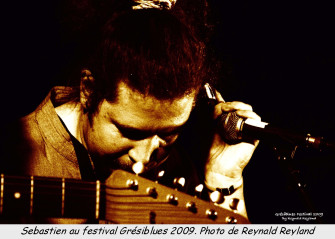 |
There are many modulations in Jazz, and different colours to be given within solos. So in that case, as I said before: a strict position playing does not work any more, or, let's say, not for a long time.
Pat:
I've read in a very interesting article (in the Web magazine Delphi'Muz) that you intended to publish a book relating the Precious Time project genesis. This is quite rare for a CD launch. Have you thought about a package with both the CD and the book? Don't you think people may only concentrate on the CD, or do you bet on the fact that they will love it and want to know more about its conception and get the book?
Seb:
I don't bet on anything Patrice, there may or may not be a pack, we will see. In fact, there is no commercial intention behind this... I just feel I have things to say and explain, so I propose them, but nobody is obliged to buy anything ;-)
I've realized, during all this time, that passionate people really want to get details, to know the reasons which encourage playing this or that, without forgetting crispy anecdotes. When I have a bit of time, I sometimes read my preferred musicians' biographies. One can learn a lot discovering their goals, their story. This book has no claim being a bio, it is just the story of the adventure we lived.
Pat:
How have you convinced these American musicians, how have you met them?
|
Seb: Curt Bisquera is a much asked percussionist in the States.
His CV is very impressive, and it would be quicker to mention the
artists he did not play with... I've contacted him simply via Myspace.
He listened to the tunes I sent him by email, and answered me
immediately that he would be delighted to join the adventure. I met
Alain Caron during Didier Lockwood concert at the Olympia (prestigious
Parisian concert hall).
|
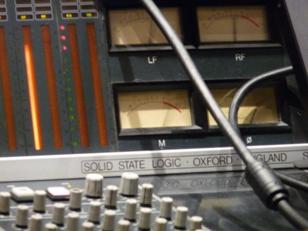 |
We had plenty of time to discuss: it's the kind of concerts with so many impressive guests, where you have to wait patiently for your turn... I therefore could take advantage of few moments with Mister Bass Fusion J. I proposed him the same thing as I proposed to Curt: playing on 2 or 3 tunes. But after listening to the tunes, each one of them answered me he would prefer to integrate the project and play on the whole album. Great idea... this I hope brought consistency and a specific "sound" to the album.
Pat:
How do they conceive the harmonica?
Seb:
Very sincerely, I think they were fortunately surprised that the harmonica could integrate this musical universe. It strongly contributed to their agreement to play on this project. As Curt Bisquera reminds it in the video teaser <http://www.youtube.com/watch?v=-6qYT04sEA0> (and in the making of included in the CD): «the harmonica in the USA, it is either the Blues or Stevie Wonder». As I am not Stevie Wonder, he expected this project to be a Blues one. Like him, I think there are American players, playing something else than Blues, who may finally be better known in France than in their country.
Pat:
Your experiences in orchestra and with Keith B. Brown are very different... Did they arrive as opportunities given to a harmonica player well known for his specific talent, or were you looking for different types of experiences? What is the main learning you got from those two experiences in particular?
Seb:
|
I wasn't looking for anything in particular, Patrice. I'm always opened to all experiences that can make me grow. I was lucky enough to be called, whether by symphonic orchestras or by Keith B Brown. Keith asked me if I was OK to play with him, knowing
there would be imposed directions, but also free parts for me on many
tunes. He wanted to change his team at that time. I guess a combination
of circumstances led him to call me... I've learnt a lot with Keith B,
who is very demanding. He exactly knows what he does not want to hear,
whether in terms of sound or in terms of time. He has a very specific
vision of the Blues, which I think is very accurate.
|
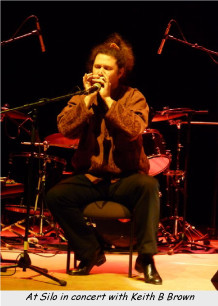 |
Playing with a symphonic orchestra is really different. The interpretation must be as precise as possible, and you have to bring a particular colour asked by the conductor. Playing «Once upon a time in the west» may seem rather simple but nothing is in that context...
When playing pieces initially composed for the chromatic harmonica, like «Macadam Cowboy» or «Touchez pas au Grisbi», it represents another kind of difficulty, but the challenge is always interesting. The most difficult to me, is to forget that if you do the slightest mistake you're dead J, themes being so precisely known by everybody... You are soloist, in front of the orchestra, so you do not have the right to fail.
I have also learnt a lot playing a contemporary piece written by G. W. Kurtag, and including 5 harmonicas. It is another culture, stakes here again differ. It is impossible to tap the foot, everything must be internal, and however it is also impossible not to count. The piece was easy on the technical plan, but a hell to count beats, the challenge was raised and the experience was very stimulating and exciting.
Pat:
Some people would like to see the harmonica in conservatoires... There are experiences in Switzerland and few other countries, but I've never heard about it in France. To your opinion, what would be necessary to make it happen here?
Seb:
In fact, it does exist in some conservatoires and private music schools. It brought a lot to the accordion. A musician like Marcel Azzola patiently worked with others to realize this integration. We already discussed it together with Marcel. I think it is essentially a question of mentality. Usually, a player who has begun diatonic has not been interested by the kind of music played in conservatoires... It is not part of his culture. Now, things can change, why not? But I don't feel the future of harmonica is in that direction.
Pat:
I understood that your influences were not coming from the "harmonica worldâ, but how do you feel the evolution of the instrument?
Seb:
Rather well in fact. I discover a lot of harmonica players through the social networks, myspace, facebook, twitter as well as on youtube. There are sometimes very interesting approaches, and much more originality than a dozen years ago. We are lucky enough to have very good harmonica players in France, and education is of quality. Forums are very active and social networks work rather well thanks to enthusiasts like you, and more generally thanks to all harp lovers. Not speaking about the choice in learning methods, which has considerably grown. Everything contributes to keep on going forward; including successful singers who can punctually use the harmonica, either by playing or by asking a harmonica player to join. It's an instrument which will certainly always find its place as an accompanist. It is often stationed at this place, but remains very popular, which is a strong advantage.
It is certainly a little more risky to continue producing albums with a harmonica as the lead instrument, but I think this can also bring a small contribution, for example by introducing the harmonica to a public which would not wait for it at a place it hasn't been fully exploited yet.
| The interview ends here. You can find the new Sebastien
Charlier CD, Precious Time, on his website http://www.sebcharlier.com |
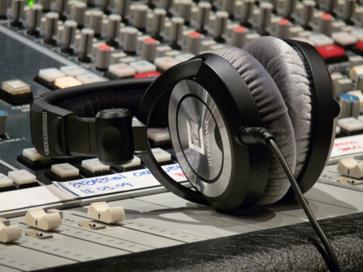
 |
 |
 |  |